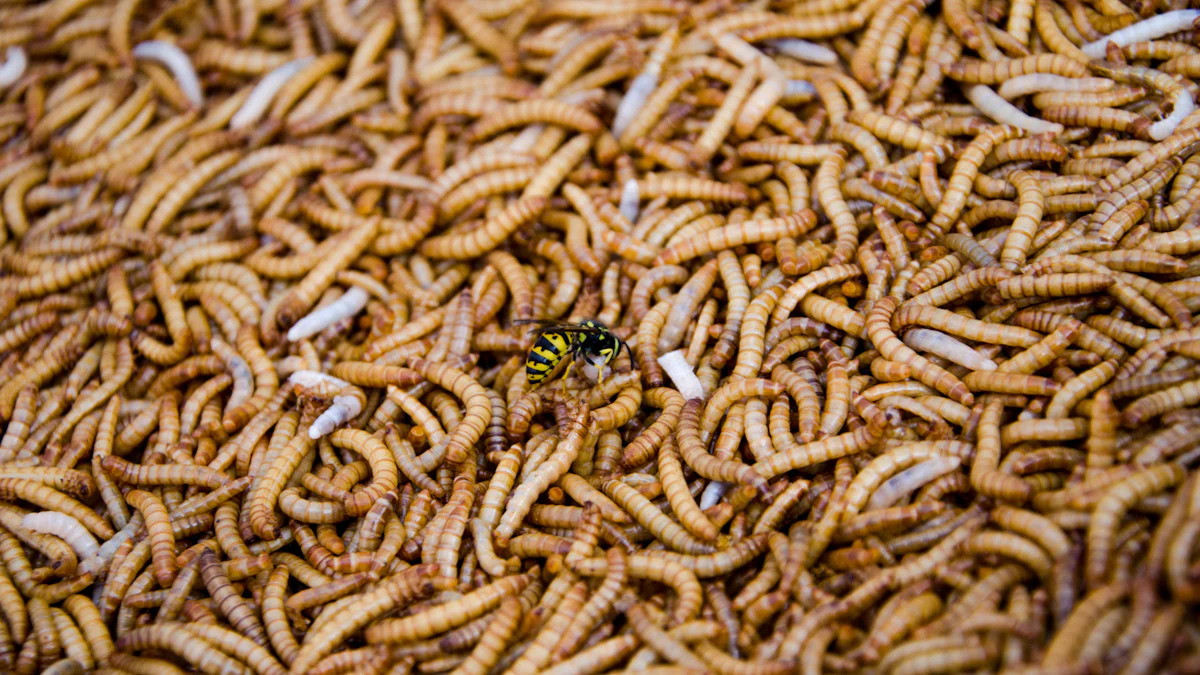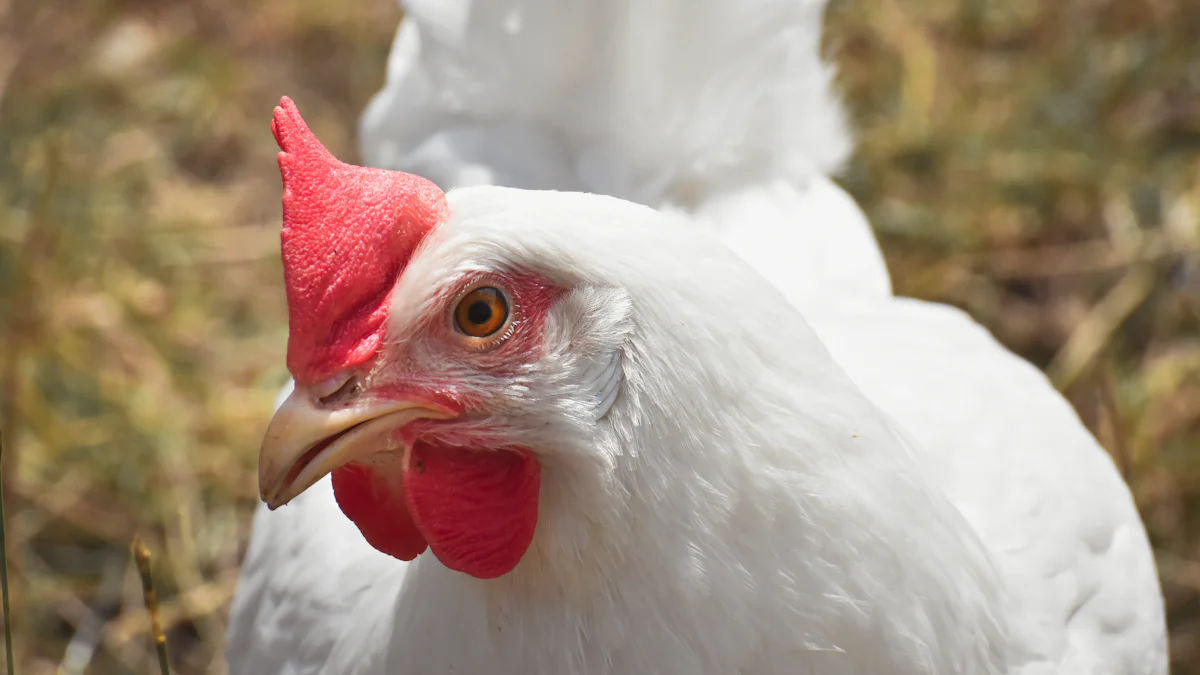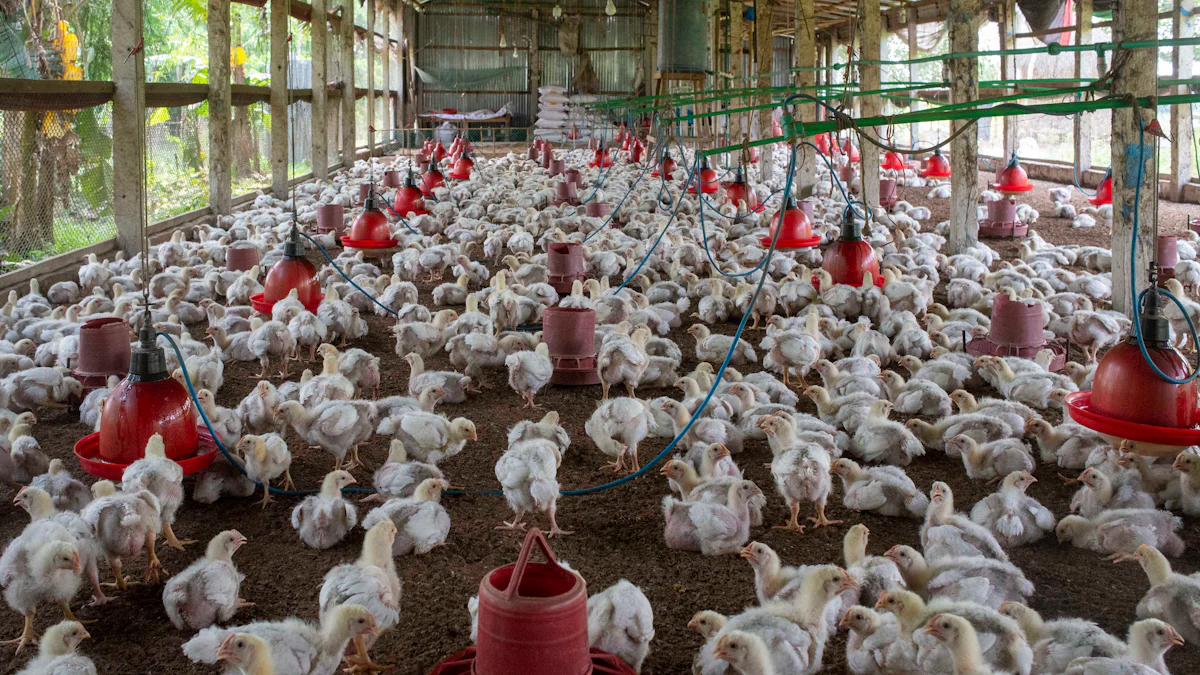
Farmers and researchers are exploring mealworms for chickens as a sustainable protein source. These insects offer a promising alternative to traditional feed ingredients. Their nutritional value could support broiler growth while reducing environmental impact. Understanding how mealworms affect growth and organ health is essential for optimizing their use in poultry diets.
Key Takeaways
- Mealworms have 40% to 50% protein, helping broilers grow muscles.
- Adding mealworms to broiler food helps them gain weight faster.
- It also improves how well they use their food, saving money.
- Mealworms help organs grow well and work better in broilers.
- They boost immunity and make broilers stronger against diseases.
Nutritional Profile of Mealworms for Chickens
Protein and amino acid content
Mealworms provide a rich source of protein, making them an excellent option for poultry diets. Their protein content ranges from 40% to 50%, depending on the mealworm’s developmental stage. This high protein level supports muscle growth and overall development in broilers. Mealworms also contain essential amino acids like lysine, methionine, and tryptophan. These amino acids play a critical role in tissue repair, enzyme production, and immune system function. Compared to traditional protein sources like soybean meal, mealworms offer a more balanced amino acid profile, which can enhance broiler performance.
Fatty acid composition
The fat content in mealworms ranges from 25% to 35%, with a significant portion consisting of beneficial fatty acids. Mealworms are rich in unsaturated fatty acids, particularly oleic acid and linoleic acid. These fatty acids contribute to energy supply and improve the quality of broiler meat. The presence of omega-6 fatty acids in mealworms also supports healthy skin and feathers in chickens. Unlike some traditional feed ingredients, mealworms contain minimal saturated fats, which makes them a healthier alternative for poultry diets.
Vitamins and minerals in mealworms
Mealworms are packed with essential vitamins and minerals that benefit broiler health. They are a good source of B vitamins, including B12, which supports energy metabolism and red blood cell production. Mealworms also contain minerals like iron, zinc, and phosphorus. Iron aids in oxygen transport, while zinc supports immune function and growth. Phosphorus contributes to bone development, which is vital for broilers. Including mealworms for chickens in their diet ensures a natural and nutrient-dense feed option.
Effects of Mealworms on Broiler Growth

Impact on weight gain
Mealworms provide a high-quality protein source that supports broiler weight gain. Studies show that broilers fed diets containing mealworms achieve faster growth rates compared to those on conventional feeds. The amino acids in mealworms promote muscle development, leading to improved body weight. Broilers consuming mealworms also exhibit better nutrient absorption, which contributes to their overall growth. Farmers using mealworms for chickens often report noticeable improvements in flock size and uniformity. This makes mealworms a valuable addition to poultry diets aimed at maximizing weight gain.
Feed intake and feed conversion ratio (FCR)
Mealworms influence feed intake and feed conversion efficiency in broilers. Chickens find mealworms highly palatable, which encourages consistent feed consumption. This increased intake, combined with the nutrient density of mealworms, results in a lower feed conversion ratio (FCR). A lower FCR means broilers require less feed to gain weight, reducing overall feed costs. Research indicates that diets incorporating mealworms for chickens can outperform traditional feeds in terms of efficiency. This makes mealworms an attractive option for improving production outcomes.
Comparison with traditional feed ingredients
Mealworms offer several advantages over traditional feed ingredients like soybean meal and fishmeal. They provide a more balanced amino acid profile, which enhances broiler growth and health. Unlike plant-based proteins, mealworms contain no anti-nutritional factors that hinder digestion. Additionally, mealworms are a sustainable protein source, requiring fewer resources to produce. This makes them an eco-friendly alternative to conventional feeds. Farmers seeking to improve broiler performance while reducing environmental impact may benefit from incorporating mealworms into their feeding programs.
Mealworms and Broiler Organ Health

Effects on organ development
Mealworms provide essential nutrients that support the healthy development of broiler organs. The high-quality protein and amino acids in mealworms contribute to the growth of vital organs like the liver, heart, and kidneys. Studies have shown that broilers fed diets containing mealworms exhibit improved organ weights compared to those on conventional feeds. This indicates that mealworms promote balanced organ development, which is crucial for overall health and productivity. The presence of beneficial fatty acids in mealworms also aids in maintaining the structural integrity of these organs. Farmers incorporating mealworms for chickens into their diets may observe stronger and more resilient flocks.
Histomorphological changes in organs
Feeding mealworms to broilers can lead to positive histomorphological changes in their organs. Research highlights that broilers consuming mealworm-based diets show enhanced intestinal villi length and surface area. These changes improve nutrient absorption and digestion efficiency. Additionally, mealworms may reduce fat deposition in the liver, promoting better liver function. The absence of anti-nutritional factors in mealworms ensures that organ tissues remain healthy and free from damage. These histomorphological improvements reflect the potential of mealworms to optimize internal organ performance in broilers.
Implications for overall broiler health
The inclusion of mealworms in broiler diets has significant implications for their overall health. Healthy organ development and improved histomorphology translate to better immunity and disease resistance. Broilers with well-functioning organs can process nutrients more effectively, leading to enhanced growth and productivity. Mealworms for chickens also provide a natural and sustainable feed option, reducing the reliance on synthetic additives. This makes them a practical choice for farmers aiming to raise healthier and more robust poultry. By supporting organ health, mealworms contribute to the long-term well-being of broiler flocks.
Safety and Practical Considerations of Mealworms for Chickens
Safety of mealworms as a feed ingredient
Mealworms have been studied extensively to evaluate their safety as a feed ingredient for poultry. Research confirms that mealworms are free from harmful substances when raised under controlled conditions. They do not contain anti-nutritional factors, which can interfere with digestion or nutrient absorption. However, the safety of mealworms depends on their rearing environment. Contaminated substrates or improper processing can introduce pathogens or toxins. Farmers should source mealworms from reputable suppliers to ensure quality and safety. Proper drying and storage methods also reduce the risk of microbial contamination. By following these precautions, mealworms can be a safe and reliable protein source for broilers.
Optimal inclusion levels in broiler diets
Determining the right inclusion level of mealworms in broiler diets is crucial for achieving optimal results. Studies suggest that replacing 5% to 10% of traditional protein sources with mealworms yields significant growth and health benefits. Higher inclusion levels may lead to imbalances in nutrient composition or increased feed costs. Farmers should consider the nutritional needs of their broilers and the specific formulation of their feed. Gradual introduction of mealworms into the diet allows broilers to adapt and ensures consistent performance. Consulting with poultry nutritionists can help farmers identify the most effective inclusion levels for their flocks.
Economic feasibility and sustainability
Mealworms offer economic and environmental advantages compared to traditional feed ingredients. They require less land, water, and feed to produce, making them a sustainable protein source. Mealworm farming generates lower greenhouse gas emissions than soybean or fishmeal production. Although mealworms may have higher initial costs, their efficiency in improving feed conversion ratios can offset expenses. Additionally, mealworms can be produced locally, reducing transportation costs and supporting regional economies. Farmers adopting mealworms for chickens contribute to sustainable agriculture while maintaining profitability. These factors make mealworms a practical choice for modern poultry farming.
Mealworms offer broilers high-quality protein, essential nutrients, and improved feed efficiency. However, challenges include cost and ensuring safe production. Research should explore cost-effective farming methods, long-term health impacts, and optimal inclusion levels. These efforts can help integrate mealworms into poultry diets, promoting sustainable and efficient broiler farming practices.
FAQ
What are the benefits of using mealworms in broiler diets?
Mealworms provide high-quality protein, essential nutrients, and improved feed efficiency. They support broiler growth, organ health, and sustainability in poultry farming.
Can mealworms completely replace traditional protein sources?
Mealworms can partially replace traditional proteins like soybean meal. Experts recommend replacing 5% to 10% of the diet for optimal results.
Are mealworms safe for broilers?
Mealworms are safe when sourced from controlled environments. Proper processing and storage ensure they remain free from pathogens or toxins.


